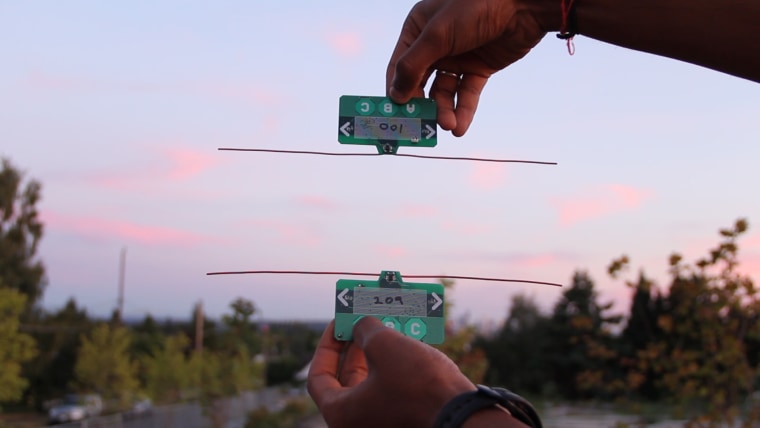A world full of Internet-connected devices is a giant step closer to reality thanks to a new communications system that works without batteries or wires for power.
Just as we use mirrors to reflect light, or turbines to catch the wind, this technique — known as "ambient backscatter"— co-opts transmissions from TV and cellular towers and reflects them to exchange information between wireless devices. These waves serve as both a source of power and carriers of information.
"We just use existing signals all around us," Shyam Gollakota, an assistant professor of computer science and engineering at the University of Washington in Seattle, explained to NBC News.
He and colleagues built a proof-of-concept system consisting of credit-card-size electronic devices that use antennas to detect, harness and reflect a TV signal, which is then picked up by similar devices.
Since TV signals are reflected off buildings, cars, trees and everything else in a city as it travels from a transmission tower to a TV set, the extra reflection doesn't degrade the signal. "Our reflection is yet just another reflection," Gollakota said.
The prototype devices communicate with each other over a distance of several feet. They flash little LED lights when they receive a signal from another device.
The applications of the technology are limitless: a keychain that sends out a text message to its owner's mobile phone when it falls out of a pocket, for instance; or an array of pad-like sensors embedded in a roof that relay a message to a homeowner when a water leak is detected.
"Because it is battery free, you can build it into the building and you never have to worry about getting at those pads again to change the batteries," Joshua Smith, an associate professor of computer science and engineering at the University of Washington, and paper co-author, told NBC News.
It is even feasible, the researchers noted, to build this technology into devices, such as smartphones, that rely on batteries as a way to extend battery life or send a text message long after the battery dies. The device would, instead, leverage power from an ambient TV signal.
"If you look at traditional communications, you are generating these signals and that consumes lots of power ... you are basically killing your battery to some degree, you are consuming power," Gollakota said.
"So, if you replace those techniques with the kind of things we are doing, then you're going to significantly reduce the power consumption of the communication itself and because you are going to reduce power consumption by communication, you are going to extend the battery life of your phone."
To get to this future Internet-of-things, the researchers are improving the efficiency of the energy harvesting technology, extending the range of the communications, and making it work with transmissions from cell towers.
The research was presented Tuesday at the Association for Computing Machinery's Special Interest Group on Data Communications 2013 conference in Hong Kong. Watch the video below for more information on the project.
In addition to Gollakota and Smith, other researchers involved with the project include David Weatherall, a professor of computer science and engineering, Vincent Liu, a doctoral student in computer science and engineering, and Aaron Parks and Vamsi Talla, both doctoral students in electrical engineering.
John Roach is a contributing writer for NBC News. To learn more about him, visit his website.
